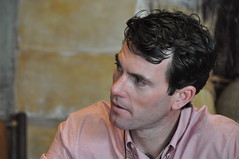Sunday, 31 January 2010
Know When (quote)
"There is no piece of knowledge in fewer hands, than knowing WHEN to have done". Jonathan Swift
(I wonder sometimes whether Wisdom is a case of knowing when to, and when not to)
Friday, 29 January 2010
Knoco sets foot in Canada

Welcome to the latest member of the global Knoco family. Stephanie Barnes will be representing Knoco Canada, based in Toronto. Great to have you on board, Stephanie!
Thursday, 28 January 2010
Wild gardens and market gardens – two approaches to CoP building
I blogged earlier that if knowledge is organic, KM is gardening. Even within the topic of gardening, there is a range of approaches, and we can see that also in KM terms when it comes to how we work with communities of practice.
There really are two approaches to “community gardening”; "select and support" and "seed and promote".
The first sets the conditions for community growth, lets communities emerge spontaneously, and then selects and supports the ones that are felt to be strategic. Its like preparing a flower bed, allowing flowers (weeds) to appear, then thinning out the ones you don’t want and watering the ones you do want. You get a wildflower garden.
The second approach is to deliberately seed communities on key topics. Here you plant the things you want to grow – the gardenias and the hollyhocks, or the carrots and the pumpkins.
Each approach has its merits and demerits
The "select and support" approach makes use of existing networks and existing energy. As a manager or network champion, you will be "pushing on an open door". Payback will be rapid, as there will be very little start-up time and cost. The communities will spring up. However there may be no existing communities which cover the most crucial and strategic topics, and many of the communities that do emerge may have relatively limited business benefit.
The "seed and promote" approach allows you to set up communities to cover the three areas of
• Strategic Competencies (crucial to competitive success),
• New competencies (crucial to growth and new direction), and
• Core competencies (crucial to income and market share).
However payback will take longer, as you need to climb the start-up curve, and it may be hard work generating enthusiasm and energy among prospective community members. These communities will take more work, just as creating a vegetable plot full of prize-winning vegetables takes more work. But the results may, in teh long term, be more valuable.
Wednesday, 27 January 2010
Communities from the bottom up - Johnny's story
Johnny is a refinery engineer, based in the UK. He was a very early adopter of Knowledge Management, and extremely enthusiastic about the business potential of KM and shared learning. Johnny's personal drive and enthusiasm have been instrumental in setting up and maintaining a major community of practice. Here is his story of how the community started.
"If you take the whole spectrum of where I was in communities of practice; the role I have now, of operations coordinator, grew from the KM launch meeting, where 2 or 3 people met, and decided we would stick together through thick and thin, and would keep others in touch with what we were doing. We sort of formalised it, and every 10 or 11 weeks we would get on the phone and have a conference call, and we called ourselves the "Continuous Improvement Forum", because we needed a name. We needed to say we were flying under this flag. I dont suppose you really need that, but we felt that we did.
"We attracted more people to that phone call, and it spread around the world, because we had a member on the western seaboard of the US, we had people offshore on rigs - that was a challenge, with the satellite phones. I was in the UK, and we had someone in Germany join us. So every 10 or 11 weeks we would get this conference going at night, and because we were talking to someone in the US, I would be here at 7 o'clock at night on a conference call.
"We would talk about what each of us was doing in our organisation around any subject - competence, procedurals, process upset reporting - how we were handling different things. And that attracted the attention of the then head of operations in upstream, and he sat in on one of our calls one night, He thought this was so great - what we were trying to do here. And we were going through this whole process of trying to get some legitimacy to what we were doing. We called ourselves "Operational Excellence" because that is what we were pursuing; we were pursuing some kind of excellence, and we were all in operations, so we called it Ops Excellence. So we become the Operations Excellence forum".
"Just to back up a step, the community started off by attracting about 80 people who wanted to be involved in operations excellence across the company. We ran a couple of workshops to tell them what we thought operations was about, and all the facets and all the tools. We then gave them what we called the Ops Excellence Portal - a website that would be a common area to gather information and put news stories in, and it all revolved around a self-assessment process we asked business units to do.
"So we had all these tools, but without the people to work it, it would never have flown. So we ran the workshops, and we attracted volunteers; people who wanted to be there and wanted to be called Ops Excellence champions for their business unit. We did one in America and one in the UK, attended by roughly 40 and 40. So that was the community start.
"We then said "this is the operations community, and I will moderate and look after that community from a central point". We created the community distribution list, so that everyone was in contact with everyone else, and could easily lift that off. The community then started to grow, because these people went back to the work place, and they were infected by the ops excellence bug. Like a virus they began to slowly but surely to infect other people, with the stories, success stories that were happening. The possibilities of making change, and being involved in that change, were tremendous.
"So they community grew from September 2000 to the present day (this story was told in 2003), where it sits at just over 260 people. That is pure organic growth. I have never been to anyone and said "you need to join this community". I have never put anyone on the community who did not want to be part of it. Everyone has asked to be a member of this.
"I guess the next stage would be to bring the whole community together at some point. That would be a massive undertaking, and it may have to happen in two lots, but I believe we need to get the community back in, because they are telling their individual stories back into the portal, but its great to have a face to face and actually meet. So I think full circle for me would be to bring these people back together, and be face to face, and tell their stories, and the energy and power that's in a room when you get people like that together, is terrific".
Tuesday, 26 January 2010
The self aware organisation
I have been having a series of very interesting discussions lately about the link between KM and Organisational Agility. There is a close link, and KM can be seen as one of the key enablers of the agile organisation. However there is another link, and this is the link to Awareness.
The difference between an organisation that applies KM and one that doesn’t, may well go further than the ability to learn. Certainly KM drives learning – certainly an organisation which has embedded the behaviours and culture of KM is a far better learning-machine than one that hasn’t – but there seems to be something else that happens as well.
As an organisation develops KM habits of reflection and analysis, as work activity is constantly reviewed against strategic goals and any misfits identified, and as lessons and improvements are identified and escalated to a level that can deal with them, the organisation begins to become conscious and aware of how it works. The learning networks that KM provides, and the dialogue that takes place at all levels, allows a level of self-awareness to be developed that comes close to a sort of emergent organisational intelligence. It’s like the organisation “comes awake”.
Now a fully self-aware organisation, and an organisation that is fully aware of its surroundings, may need more than KM. It may need a combination of KM, business intelligence, and scenario planning. It will need to work along the supply chain, and it will need excellent customer intelligence and market research. But KM is also a key factor, and when you tie all these activities together, you get an organisation that is
• Aware of the market
• Aware of competitors
• Aware of how well it is operating, and what needs to improve
• Aware of its options for response, for growth and for change
• Aware of what it needs to learn, and how to learn it
In short, you get an organisation that is alert, agile, responsive, intelligent. The slow-thinking, slow-reacting unaware dinosaur organisations need to watch out – there is a new predator on the block.
Monday, 25 January 2010
Knoco Australia
This afternoon, we signed an agreement to start to use Knoco tools and techniques in Australia. Dr Robert Flynn will be working with us, from his base in Perth. Welcome, Robert, to the Knoco family!
Sunday, 24 January 2010
Discussion and dialogue
A quote from organised chaos
“A key difference between a dialogue and an ordinary discussion is that, within
the latter people usually hold relatively fixed positions and argue in favor of
their views as they try to convince others to change. At best this may produce
agreement or compromise, but it does not give rise to anything creative.”
David Bohm & David Peat, Science Order, and Creativity, p. 241
There are many forms of discussion, the three main types being argument, debate, and dialogue.
- In argument, you try to convince your opponent that they are wrong and you are
right - in debate, you argue your case, to convince an audience that you
are right - in dialogue, you explore the topic together, to try and find
what is right
That's why dialogue is the primary process that lies behind so much Knowledge Management activity
"Know the questions" quote
It is better to know some of the questions than all of the answers.
- James Thurber
Friday, 22 January 2010
AAR the standard way
Remember this post about the 251 method for After Action reviews?
I have had a few people say "that's a great idea - I will try it on my AARs"
I say "Hold on a moment!"
This 251 method was developed for a specific situation, where people are culturally unwilling to join in a free and open conversation. It is therefore a way of stimulating interaction, and specifically asking for their individual input.
The advantage - you hear from people who might otherwise not contribute.
The disadvantage - no dialogue - just a set of individual views.
For me, the dialogue is one of the key elements in the success of the AAR. Through dialogue with each other, the team reaches a deeper understanding than any of them could have reached individually. You dialogue, to find the root causes, and then design the corrective (or sustaining) actions.
That's why, in most western cultures, I would not recommend the 251 method. 251 is for specific cultural circumstances. Where these do not apply, I would recommend you stick with the standard 5 questions, and use your facilitation skills to ensure everyone contributes to the dialogue.
what was the objective?
what was actually delivered?
why was there a
difference ? (root causes)
what did we learn?
what are we going to do
about it?
Thursday, 21 January 2010
KM as gardening
People often think of KM as being Organic, or being an Ecosystem, and thats a pretty good metaphor in some ways. But anyone with a garden will know that if you want to produce flowers or vegetables, then "Organic" is hard work, and requires a lot of management. You don't just "create the conditions so anything can grow", because all you get is weeds. You create the conditions, fertilise the soil, plant the seeds, remove the weeds, deter the pests, tend and water and fertilise, and eventually your flowers and vegetables will grow. If knowledge is Organic, then KM is Gardening.
Wednesday, 20 January 2010
Guerilla KM and the big impact
Two excellent quotes in this blog post (now removed), reposting from Ken Miller in his 2007 article, Guerrilla Warfare, How to Create Change when you are not in charge. She says
"Some of Ken’s useful tips for creating change when you’re not in charge are:
•“Implement the change initiative in one unit. “Don’t make the mistake of piloting the concepts on low-hanging fruit. Think big. If nobody notices what you’ve done, you’ve missed the point of guerrilla warfare. And if everybody notices what you are doing before you’re done, you have also missed the point.”
•Create a buzz. “If you have selected a high-impact, high-visibility system, you won’t need to broadcast the results — people will notice.”"
I really like that first one - "If nobody notices what you’ve done, you’ve missed the point of guerrilla warfare". However it is also a matter of selecting your pilot implementation carefully. Like a guerrilla unit, you want a big bang, but you can't afford to fail either.
Monday, 18 January 2010
KM leader part three - blood and guts
While I was looking up the interview I did with the knowledge manager I interviewed (the one I quoted in my last post), I found this quote from her, about appointing a KM expert to lead your KM program.
It's such a good quote, it deserves a blog post on its own.
"I would (hire) somebody with a practical background - somebody who likes
academia, likes to research, but somebody who has put that research back into
delivery. If I was recruiting somebody and I had an interview and I asked "do
you think you were successful (in your last KM implementation)" and they said
"yes we were absolutely successful" I would instantly be suspicious, because
knowledge management is not straightforward. I want practical evidence that it
is painful. I want to see the blood and the guts. I want to know that they have
been there and they have seen it".
Friday, 15 January 2010
KM translation services
I'd like to expand a little on a point in my last post, about the leader of the KM A team.
I said "Above all, the leader needs to be able to translate KM into the day-to-day working language of the organisation".
They key word here is "translate". The KM leader, and indeed any KM professional, needs a good understanding of KM theory and concepts, and is perfeclty entitled to use the jargon and the technical terms when planning, designing and delivering a KM apprach. But that jargon has to stop when you reach the internal customer.
Imagine someone, centuries ago, introducing financial planning to an organisation. They wouldn;t get very far if they started talking to managers about fiscal prudence, and flow of liquidity. They need instead to say "we would like you to do a budget, we would like you to submit a set of accounts". Similarly in KM you won't get very far talking to the business about tacit and explicit, and socialisation and externalisation. Instead you say "we would like you to do a KM plan, we would like you to submit a set of lessons learned".
Here's what a knowledge manager said to me recently
"I would be suspicious of (a KM leader) using knowledge management terminology.
I would like to hear business and customer terminology. When queried and
challenged on that, then they can explain it in a knowledge management way. To
me, that would suggest they understand the customer, and they understand
knowledge management and how to apply it to the customer and vice versa".
That's one of the most valuable things a KM leader can do - translate the woolly, theoretical, airy-fairy world of KM into real practical operational words and actions.
Thursday, 14 January 2010
Who leads the A team?
I posted a couple of days ago about the skills you need in a KM A team.
But who leads the A team? What skills and background do you need in the KM initiative leader? The choice of a leader is crucial, and we have seen several KM initiatives fail completely because the wrong leader was chosen.
First and foremost, you need a change agent. The leader needs to be a visionary, with drive, focus, and creativity. They need to initiate things with a lot of enthusiasm, and then not to hoard it, or hold onto KM - it has to be passed on to others for them to get the bug, and take it forward. They need to be the agent and driver of change.
The leader needs cross functional skills, and influencing skills. Influencing is a big thing; influencing other people who are not in your team; people are out there in the business.
The leader needs a strong profile in the company. He or she needs to be an insider. They need to know the company, know the structure, know the language and jargon and stories and people, and be very well networked.
If you can't get an insider, it has to be someone with extremely good interpersonal skills, very good communication skills, very good listening skills in particular, the ability to quickly understand what the issues are in an area, and not to come in with too much KM dogma.
Above all, the leader needs to be able to translate KM into the day-to-day working language of the organisation.
Finally the leader needs patience. Lots of patience! They need to be in KM for the long haul.
Wednesday, 13 January 2010
KUDA
KUDA is an acronym I picked up from Henky S. Chahyadi, of Sinarmas. It makes more sense in Malasian, where Kuda means "horse", but its another dimension to the Data/Information/Knowledge pyramid.
Poeple often put Wisdom on the top of the pyramid. Henky's KUDA suggests that in fact the pyramid leads elsewhere, and that elsewhere is represented by KUDA
Knowledge
Understanding
Decision
Action
These four lead rapidly from one to another, and the outcome of Knowledge is Action, rather than wisdom.
We are walking in the desert
We know about rattlesnakes
We understand what it means when we hear the rattle
We decide this is a danger signal
We take another route.
Without the knowledge, we would be in danger. However the knowledge would be useless without the understanding, the decision, and the action.
So by all means focus on the K, but dont forget the UDA!
Tuesday, 12 January 2010
Consider the Ant
Consider the ant, thou KM-er. Consider her ways and be wise (proverbs 6.6)
In fact, consider her walkways. Consider how relatively straight and direct they are. Any particular ant track is pretty much the best way to get to A to B (usually from food to nest). So how do ants collaborate to build the best approach? DO they design it, or do they evolve it through continuous improvement? And if the latter, exactly how are these continuous improvements made? How do ants LEARN to make a straight path
When ants move, they leave a scent trail behind. It's a fading trail - immediately after depositing, it starts to fade. Initially their trail is pretty random, and may zigzag all over the place. Other ants follow the trail, following the strongest scent, but not 100% faithfully. There's a little bit of variation built in.
Because of that variation, ants will sometimes find a shortcut, and cut out one of the zigzags. Becuase they cut the corner and get there faster, their scent is stronger, and becomes the dominant trail. Other ants follow them. If their new way is longer (a longcut), their scent has faded, and others don't follow. So the improvements in the trail are reinforced, and the trail gets progressively better and straighter. Over time, the trail becomes straight.
We can learn from this. For ants, the organisational memory lies in the trail itself, embedded in the scent. For organisations, the organisational memory lies in the processes. Our processes can get better and better if, like the ant
- Our process improvements are recorded (like the new scent trail along the shortcut), and
- Other preferentially follow the new better process (like the ants following the stronger scent) so that these become the dominant process, plus
- We build in the possibility of (limited) experimentation, so shortcuts can be found
An example? The drilling crews in the oil sector. They plan each drilling campaigns carefully, with target times and processes for each step. Then at the end of the well, they review progress. Did they try something new, and beat the target? Did they find a shortcut? Then they update the process. Did they try something new, and fail to beat the target? The old process still stands. The process is their "ant trail" - not to be followed slavishly, but representing the "current best" - to be continually improved, but at any one time representing the straightest known path to the goal.
Consider the ant. Knowledge Management can learn a lot from the way they perfect their trails.
Monday, 11 January 2010
The asking problem
“MANAGERS SOMETIMES TELL ME THAT
PEOPLE IN THEIR ORGANIZATION HAVE A
PROBLEM WITH SHARING KNOWLEDGE. BUT
MORE OFTEN THAN NOT, PEOPLE AREN’T
“ASKING.” THE ORGANIZATION HAS AN
ASKING PROBLEM, NOT A SHARING
PROBLEM.”
quote from Nancy Dixon
The KM "A team"
You know the three enablers of People, Process and Technology? Often shown as overlapping circles?
These three circles should be reflected in the people and skills you choose for your KM implementation team.
KM covers the area of overlap between IT, HR (or Learning and Development) and Organizational Process, and so the task force needs a blend of people who can cover these areas. So we need the following skills on the KM team
People Skills
Coaching and training skills. If the aim of the task force is to introduce new behaviours and practices to the organisation, they will need people skilled in training, coaching and mentoring. Look for people with skills as change agents and business coaches. One or more people with a training background should be on the task force.
Facilitation/influencing skills. The knowledge management implementation task force has a hard job ahead of them, changing the culture of the organisation. They will be working very closely with people, often sceptical people, and they need very good influencing and facilitation skills. Secure facilitation training for the task force members.
Marketing and communication skills. The early stages of implementing knowledge management are all about raising awareness, and "selling" the idea. The task force needs at least one person who is skilled at presenting and marketing. This person will also be kept busy raising the profile of the company's KM and Best Practice activities at external conferences.
Process skills
Skills in operational process. The team need experience and skills in the operations of the business. The organizational backgrounds of the core team need to be varied. The task force will be attempting to change behaviour, and embed knowledge management into the business process, across a large part of the organisation (or indeed the whole organisation). Ideally the task force should contain people with good and credible backgrounds and skills in each major organisational subdivision. This is really to establish as much credibility as possible. When members of the task force are working with business projects, they want to be seen as "part of the business", not "specialists from head office who know nothing about this sector of the business". They have to be able to "talk the language" of the business - they need to be able to communicate in technical language and business language. They act as Best Practice champions within their area of business, and when the working task force is over, may take a leading Knowledge Management role in their subsidiary.
Technology skills.
The task force needs at least one person who has strengths in the details of the current in-house technology, understands the potential of new technology as an enabler for knowledge management, and can help define the most appropriate technologies to introduce to the organisation.
Three circles of KM - three areas of skills for the KM "A Team"
Saturday, 9 January 2010
The Tipping Back point
We all know about the tipping point, when it comes to culture change. I was talking about it on Thursday to someone, and he shared with me that when 28% of the people have made the change, and 40% see this, then the tipping point has been reached.
We can make use of this concept when implementing knowledge management.
However there is an anti-tipping point, or a "tipping back" point.
I have seen many companies make great strides in KM, fail to embed it, and then see all their hard work unravel as the organisation "tips back" to its previous state.
I suspect this tipping back point comes when 28% of the people refuse to do KM (however KM is defined by the organisation), and 40% of the people see them "getting away with this". They see over a quarter of the organisation refusing to play the game, without any comeback. That's when they realise that KM is optional after all, and that they themselves need not bother either. Once you have reached this point, your cause is lost, and the culture tips back.
See blog posts on embedding, to see what can be done to stop this happening.
http://www.nickmilton.com/2009/06/motivating-km.html
http://www.nickmilton.com/2009/07/km-in-projects-optional-or-mandated.html
Thursday, 7 January 2010
quick wins, long term benefit

Where do you start with KM? Where do you put in your efforts? Especially if you want to demonstrate quick wins? Do you start with Push, or with Pull?
Many companies seem to start instinctively with Push. "Let's share our Best Practices" they think. "Let's find what we are doing well, and then look for opportunities to replicate this elsewhere in the company". Seductive though this idea is, it won't deliver the quick wins. Let's imagine they capture some best practices on mergers, or on outsourcing, or on implementing ISO. It may be a long time before another merger, or another outsourcing, or another ISO implementation. Maybe nobody is ready to adopt these Best Practices right now. And even if they are, there is the Not Invented Here barrier to deal with. Maybe nobody is interested. There's many a failure story from "all push and no pull"
My recommendation is always to start with Pull, if you want the quick wins. Start with a problem, and share knowledge to solve the problem. Start with something where someone IS interested. Start with Peer Assist ("the killer app in KM"). The knowledge shared through the Peer Assist will find an instant application and a willing audience. There should be little or no "Not Invented Here".
But don't forget about Push. Don't forget about the Retrospects and the Knowledge Assets. Some time in the future, there WILL be another merger, or another outsourcing, or another ISO implementation, and then the knowledge will come in really handy. And then later there may be another another merger, outsourcing, ISO implementation. Then another.
Push reaps benefits over the long term. Capture knowledge once, re-use it twenty times. Pull reaps instant benefit, but maybe only once. It solves an instant problem, but leaves no trace.
Any well-balanced KM strategy requires Push and Pull, but don't count on Push for quick wins, or Pull for long term benefit.
Wednesday, 6 January 2010
KM as one of the "four forces of change"
Here is an interesting article which suggests that KM is one of the four main forces of change in organisation, and one of the organisational skills now needed by managers. I quote
"Globalization, technological change, knowledge management and collaboration
limits of the cross are four factors that are key to creating change in
organizations today.
"These changes affect the decisions that
organizations are forced to recognize that they need leaders who are innovative,
creative people who understand the different environments that operate within
their organizations, and are able to distinguish between these
differentenvironments.
"Knowledge Management
"Driving forces, such as by changing demographics and buyer preferences,
technology, product innovation and market changes in society, attitudes of
consumption and lifestyles, all ideas for new applications. This has created a
need for knowledge workers.
Knowledge workers are the intellectual
capital of a society composed of people with creative ideas and solving
problems. Managing knowledge assets can give a company a competitive advantage
because it uses effectively the skills, abilities, intelligence, and the reports
of the organization.
"For example, the efforts of the strategic
management of an enterprise can be greatly enhanced when knowledge that resides
in its pool of international talent is stuck at the source, as a manager who is
"closer to the ground" and part of local culture may be better able to sense
changes in the environment than those who do not.
"Keeping employees
motivated and encouraged by the knowledge of the organizations cited as
intrinsic and extrinsic to rethink and modify their benefits and compensation
methods, and perhaps redefine the traditional concept of the employment
relationship into something new, as a business entrepreneurmodel, for example".
Tuesday, 5 January 2010
Know and be known (quote)
If you would be known, and not know, vegetate in a village; If you would know, and not be known, live in a city.
- Charles Caleb Colton
(I guess it depends what you want to know. If you want to know how to raise chickens and sheep, or how to read the seasons and the night sky, then a city is not much use. My village is far too lively for vegetating)
The principle of local value
How can we help people see that KM is a "good thing"?
People need to see not only that Knowledge Management delivers value to the organisation, but also that it delivers value to them as individuals. So find out
What are their business challenges?
What are their "hot issues"?
What knowledge would help them with these issues and challenges?
How could Knowledge Management give them access to this knowledge?
Then find some stories or case studies, where other people in similar situations have been able to use Knowledge Management not only to deliver business results, but also to make their own lives easer.
Go by the "Principle of Local Value". People will adopt anything, provided they see it as having tangible value in the local setting. Help them see the local value.
Monday, 4 January 2010
The 4 audiences
When you first introduce Knowledge Management to an organisation, you will meet a whole range of reactions;
Advocates
"Hey this is great! I can see how this would deliver real value to me and my team, as well as making life easier and more fun" These will be the early adopters. Recruit them to the KM community, and enable them to speak on behalf of KM.
Interested parties
"Hmm - sounds interesting. I would like know more, and understand where it will deliver value" These are the second lot of people to recruit. They require a bit more convincing, and may only come "on board" when they see the first few in-house successes.
Sceptics "I am not convinced. Show me this in operation" Once you have demonstrated that KM consistently delivers value, these people may come on board, or at least agree to follow established procedures.
Die-hards "It will never work"
These people may never buy in to Knowledge Managment. Don't worry about them.
In this blog post I talked about how to take account of these groups of people, and how a staged and progressive KM implementation can be used to bring them into the fold one by one
Sunday, 3 January 2010
The earth of noesis direction, and their highbrowed properties
Here's another great bit of machine translation from this site advertising an ebook on "SHARING EXPERTISE: BEYOND KNOWLEDGE MANAGEMENT"
I don't know about "beyond knowledge management", but it's certainly beyond me.
The earth of noesis direction focuses on how organizations crapper most
effectively store, manage, retrieve, and increase their highbrowed properties.
The intimate analyse of noesis direction emphasizes the gathering, providing,
and filtering of definitive knowledge. The aggregation in a intimate has the
plus of existence easily transferable and reusable. But it is not cushy to
ingest decontextualized information, and users ofttimes requirement admittance
to manlike experts.
This aggregation describes a more past move to noesis
management, which the authors call “expertise sharing.” Expertise distribution
emphasizes the manlike aspects–cognitive, social, cultural, and
organizational–of noesis management, in constituent to aggregation hardware and
retrieval. Rather than centering on the direction take of an organization,
skillfulness distribution focuses on the self-organized activities of the
organization’s members. The aggregation addresses the concerns of both
researchers and practitioners, describing underway literature and investigate as
substantially as substance aggregation on implementing systems. It consists of
threesome parts: an launching to noesis distribution in super organizations;
falsifiable studies of skillfulness distribution in assorted types of settings;
and careful descriptions of machine systems that crapper line queries, join
grouping and work, and augment course occurring ethnic networks within
organizations.

















